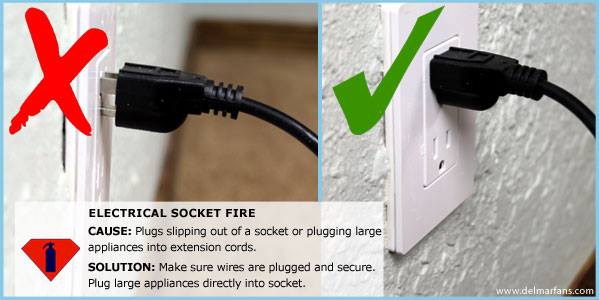Fire Safety Tips
Most of us are completely lost without the electrical appliances and gadgets that fill our homes and offices. We use them every day and are surrounded by them, so we don’t stop to think about how dangerous they can be. Electrical cord safety is important because a frayed or broken cord can easily start a fire.
This list of Do’s and Don’ts will help you maintain cord and fire safety in your home, so you can enjoy your devices securely for a long time.
DO use extension cords only when absolutely necessary. It’s better to plug items directly into outlets, so try to arrange items so they are as close to outlets as possible.
DON’T connect a series of shorter extension cords together. This can be extremely hazardous and raises the risk of fire. If you need a longer cord, there are many sizes available on the market, even going up to 100 feet long.
DO inspect cords on a regular basis for signs of fraying and wear. Damaged cords can lead to fires. Throw away frayed or broken cords; replacements for any cord are available online and even a pricey cord is less expensive than the insurance deductible for a house fire.
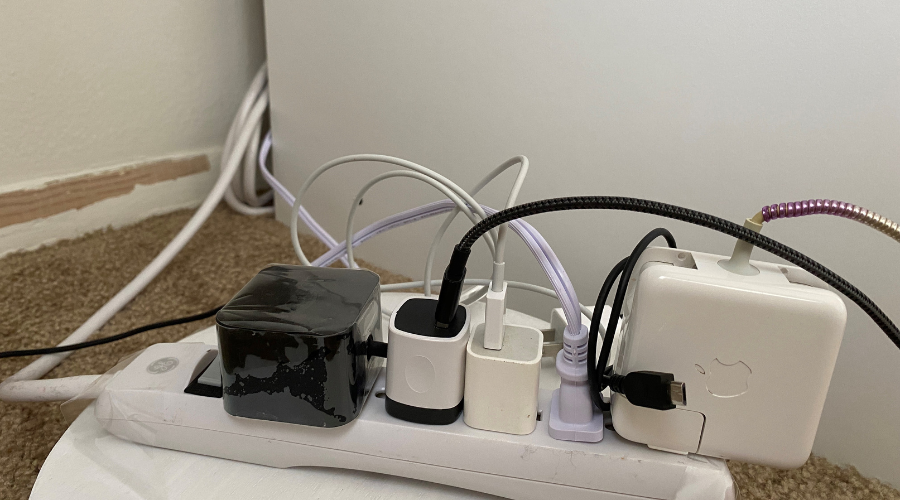
Cords and wires are often knocked loose or pulled out of their sockets, especially in high-traffic areas like kitchens and offices. If you accidentally unplug a cord that is still in use, it can cause serious injury to people, pets, and property.
DON’T leave cords dangling where people can trip over them and hurt themselves. This is also important if you have a puppy who loves to chew things. Not only will the cord be damaged, but a puppy could be hurt by chewing a cord that’s plugged into an outlet.
DO check the maximum capacity of cords and be sure to stay within that range. Going beyond the maximum capacity can blow fuses or start a fire.
DON’T nail or staple cords to walls or other items. The nails or staples can penetrate the coating of the wires and cause a short circuit, which can lead to a fire.
DO avoid overcrowding outlets by using Bluetooth technology. A printer plugged into an outlet on one wall can be connected to a computer plugged in across the room via Bluetooth without resorting to power strips or extension cords.
DON’T stretch extension cords across job sites. They can be damaged by chemicals, tires, feet, and water. A construction worker who trips over a cord on a job site can be injured more seriously than an office worker who trips over a cord in a business. Many construction tools have cordless versions with heavy-duty batteries that eliminate the need for cumbersome cords.
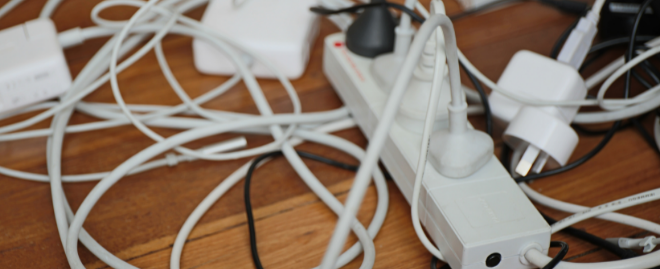
Cords, cables and power strips can be a tripping hazard in your home if not kept tidy.
DO keep cords neatly organized and out of the way with approved ties or cord bundling devices. Consider labeling the ties or devices as you go, so you won’t have to play “trace the cord” when you want to unplug a game system or DVD player from the TV.
DON’T plug extension cords into surge protectors. Extension cords can get hot quickly, especially if other plugs are in the nearby outlets. Be sure to use an extension cord that is long enough for the job every time. It’s a good idea to invest in a few different sizes so the right one is always on hand. Extension cords are relatively inexpensive and can be found at hardware and big box stores, as well as online. It’s a small price to pay for extension cord safety.
Electrical cord safety is mostly common sense, along with a few minutes of inspection when using an electrical device. This way, any fraying or breakage is discovered immediately so a repair or replacement can be made quickly. Checking devices whenever you use them is probably the easiest way to practice fire safety at home or at work.
Electrical fire smell toxic
You can smell toxic smoke before you see it. This is because many of the chemicals in electrical fire plumes are heavier than air and tend to settle near the floor. The smell of an electrical fire is toxic and sooty. The smell is similar to the smell of burning hair and/or plastic. Avoid contact with skin or eyes. Do not breathe fumes.
Exposed cables or power outlets can create potentially dangerous sparks. The electrical fire smell is a symptom of an electrical fire, or failure of the earth wire in your electrical circuit. It is a warning that there is damage to your home’s electrical system and you may be at risk for electrocution or fire.
When an electrical fire breaks out, it causes acidic fumes that become toxic to breathe in. Electrical fire smell toxic as it has adverse effects on the respiratory system and may also cause medical problems. The symptoms of this harmful exposure are similar to those shown by asthma, pneumonia, bronchitis and allergic rhinitis. If you experience any of the following symptoms after an electrical fire, you should seek medical attention immediately: difficulty breathing, skin irritation or redness, coughing, or wheezing.
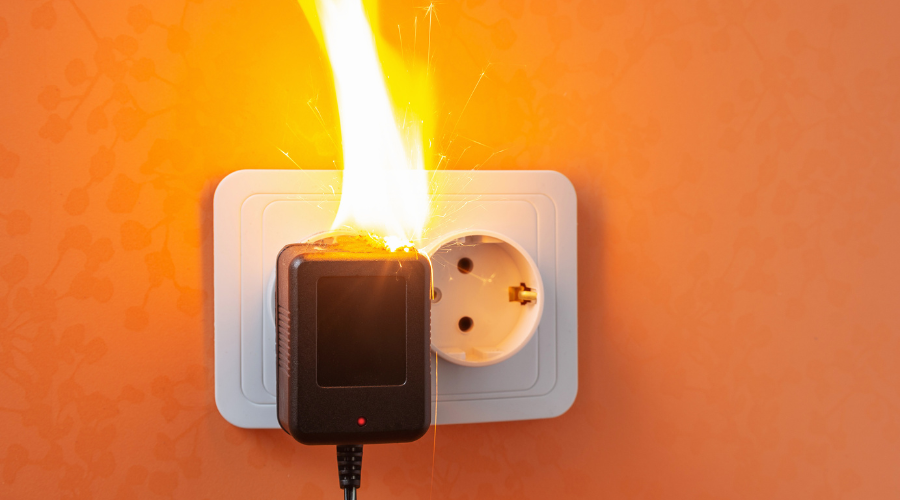
When you smell a potent, unpleasant odor after a lightning storm or in the home, it is probably electrical fire. The odor is toxic and should be handled by a professional.
How to put out an electrical fire?
The key to putting out an electrical fire is to shut off the power at its source. To do that, turn off and unplug any powered appliances or wall outlets near where the fire is burning. If you can’t see where the power source ends and begins, use your senses: if you smell burnt wire, you’re close; if the smoke is coming from one particular device such as a heater or printer, shut it down immediately.
After turning off all power at your electrical service panel, use an extinguisher to put out an electrical fire. If possible, use a CO 2 or halogen-based extinguisher because it won’t spread the flame further or leave a residue like water would. If the electrical source is not shut off, use the wrong type of extinguisher and you may cause an explosion.
Electrical fires are an emergency situation, even if the fire is small. Evacuate the building. Call 911. Get upwind from the fire if possible; do not stand near windows, doors, or walls that could become damaged by fire-related damage. Keep others away from the area until it is determined safe to reenter.
Fire Damage Restoration
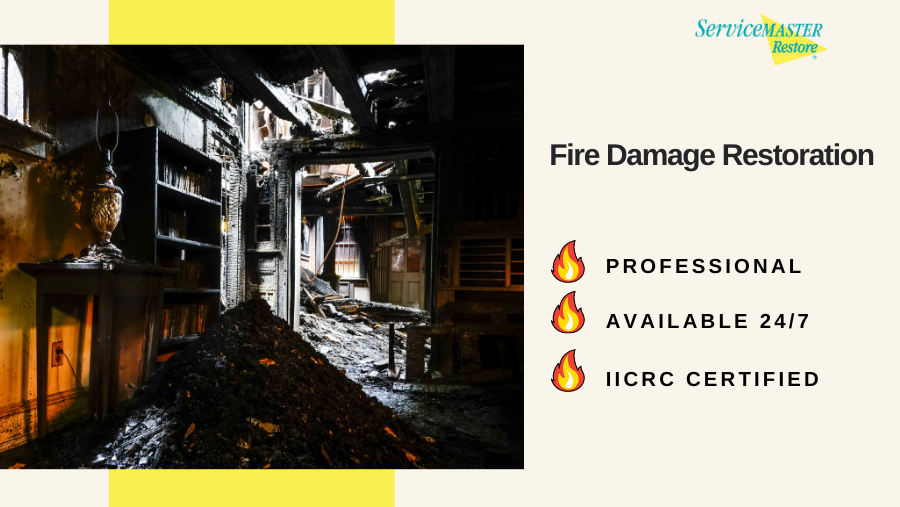
If you experience fire and/or smoke damage in your home or business in San Francisco, CA or anywhere in the Bay Area, it’s important to call a restoration company, like the professionals at ServiceMaster DDR at (800) 439-8833 as quickly as possible. Even after the flames are out, the structure and contents are still vulnerable to damage from smoke, soot, water, and firefighting chemicals. Without fast restoration, this damage will be permanent. Even worse, mold starts to grow within 48 hours of exposure to excess water, which is the last thing someone needs after a fire. Our technicians have years of experience repairing the damage from fires of all sizes and will restore residential and commercial properties to their pre-disaster states quickly and efficiently.
Smoke and fire damage restoration costs vary, depending on the extent of the damage and the number of items that need to be repaired.
Related Fire Topics:
Types of Fires and How to Extinguish Them
How to Get Rid of Fire Smoke Smell
Wildfire Forest Fire Smoke Odor in Your Home – How to Remove
How to Clean Fire Damaged Walls
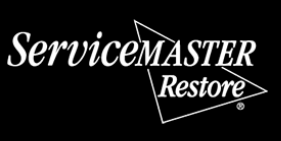
Steve VanDenBerg is the owner of ServiceMaster Disaster Restoration and Recovery. He has over 30 years of experience working within the restoration industry and successfully leading start-ups, turnarounds, acquisitions and mergers, and rapidly growing companies.
Steve earned his BS in Business & Accounting from Calvin University in Grand Rapids, MI and began working for DSI Holdings as their Chief Financial Officer. When Steve began with DSI Holdings, they were running an underperforming ServiceMaster Restore franchise with one location. Steve implemented new policies and procedures for accounting and finance as well as a professional sales plan that increased profits eightfold over his time as the CFO. He was then promoted to President and CEO and in this time, he expanded the company from two locations with $4M in sales to 12 locations and $45M in sales. DSI Holdings became one of the largest disaster restoration companies in the U.S. and helped with major restoration projects throughout the U.S. and around the world.
Steve purchased ServiceMaster DRR in 2015 when the business was in decline. Drawing on his years of experience in turning around struggling ServiceMaster franchises, Steve overhauled our operations, including finance, sales, and marketing, which led to a quick turnaround. Within Steve’s first 24 months, sales increased by 60 percent. Steve also helped greatly improve our operating margins and established a relationship with California’s largest residential insurance company. Under Steve’s leadership, we have become one of the largest disaster restoration providers in California.
Steve has found great success in turning around struggling and stagnant restoration franchises by changing the business model and strategy, greatly increasing sales and profits. Many of the changes he has implemented have even been adopted by the franchisor into their operating model.



